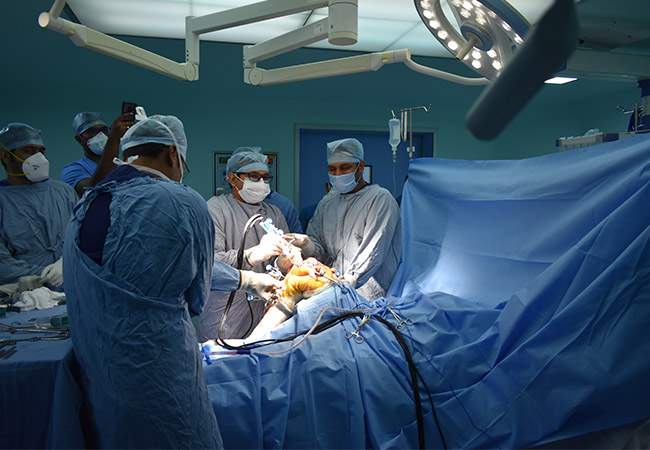Robotic Surgical System can help your surgeon get you back in action with accurate and precise knee replacement technology.
Robotic surgery does not mean that an actual robot performs the entire surgery. Instead, doctors use a robotic surgical arm to execute parts of the procedure, assisting in areas that demand the steadiest hand and navigating small places. Robotics becomes another tool in the doctor’s kit.
Using CT scans, the robotic arm can work from 3D images of the surgical area and perform a range of tasks, such as:
- Prepare the bone.
- Introduce the implant.
- Balance the implant.
- Check for the right fit.

Robotic Total knee arthroplasty(TKA) uses computer software to convert anatomical information into a virtual patient-specific 3D reconstruction of the knee joint. The anatomical information may be obtained using preoperative CT (image-based) or a combination of preoperative radiographs and intraoperative osseous mapping (imageless). The surgeon uses this virtual model to plan optimal bone resection, implant positioning, bone coverage, and limb alignment based on the patient’s unique anatomy. An intraoperative robotic device helps to execute this preoperative patient-specific plan with a high level of accuracy. The action of the saw blade is confined to the preoperative surgical plan for femoral and tibial resection, which limits iatrogenic periarticular soft-tissue injury and bone trauma. Although the first robotic TKA was performed in 1988 using the ACROBAT robotic system (Imperial College, London, United Kingdom), there has been a surge in robotic TKA over the last decade. This has been attributed to recent developments in computer software and technology, and the ease with which modifications can be made to existing technology such as computer navigation. Computer-navigated TKA provides patient-specific anatomical data with recommendations for bone resection and optimal component positioning. Robotic TKA takes this one step further by actively controlling and/or restraining the surgeon’s motor function to improve the accuracy of achieving the planned bone resection and implant positioning.

ADVANTAGES OF ROBOTIC KNEE SURGERY
- Lower Long-Term Costs
- Better Patient Outcomes
- Higher Patient Satisfaction

